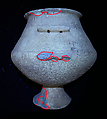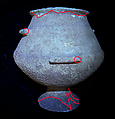On loan to The Met The Met accepts temporary loans of art both for short-term exhibitions and for long-term display in its galleries.
Marble vase with high foot and lug handles
Technical analysis: Ultraviolet-induced visible luminescence examination, optical microscopy
This beautifully crafted collared jar with a hemispherical body set on an outsplayed pedestal base and with a broad conical collar with everted rim set off from body by a groove is evolved from the Early Cycladic I footed collared jar, or kandila. Three rectangular unpierced horizontal lugs are placed equidistant at the widest part of body. Two more rectangular pierced horizontal lugs are set opposite each other midway up the collar. It is complete and restored with losses at the rim and base and three of the five lugs. Pale brown accretion covers the vessel in varying degrees. Apart from the weathered/repaired rim and foot and losses in general, the marble is smooth and intact where visible. This is an extraordinary work of fine craftsmanship that would have had a flat circular marble lid, like the very similar complete example from Naxos, but nearly twice its size. (1) The pottery version of this form, see L.2022.38.159, is a very common grave good in the Early Cycladic II period, rarely found in settlements.
Sandy MacGillivray and Wendy Walker
(1) See, Getz-Gentle, P. Stone Vessels of the Cyclades in the Early Bronze Age: Pennsylvania, Pennsylvania State University Press, 1996, 297-8 N5, Pl. VIIIA, fig.97b; from Naxos, NAM 6133.2.
This image cannot be enlarged, viewed at full screen, or downloaded.
This artwork is meant to be viewed from right to left. Scroll left to view more.









